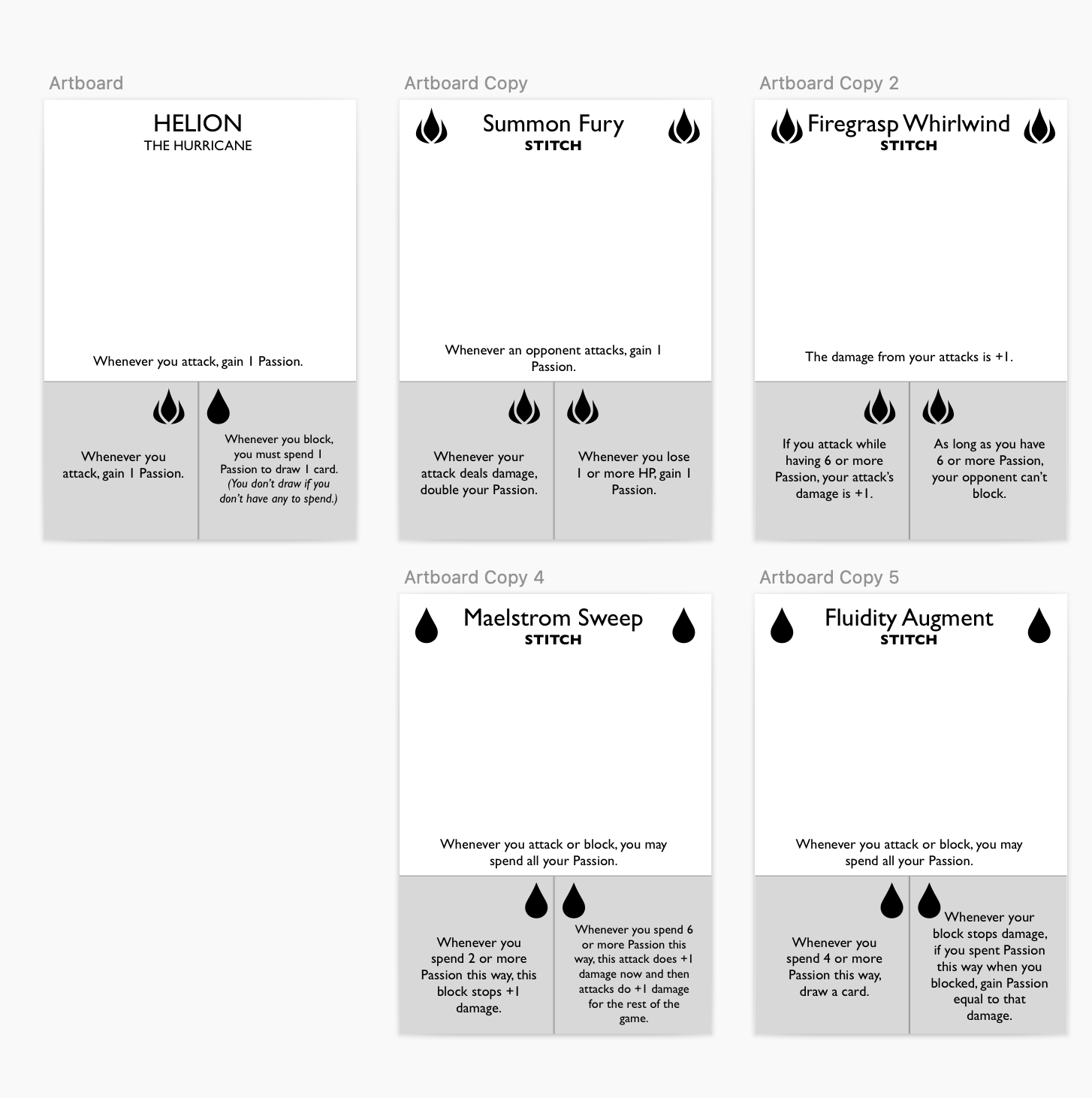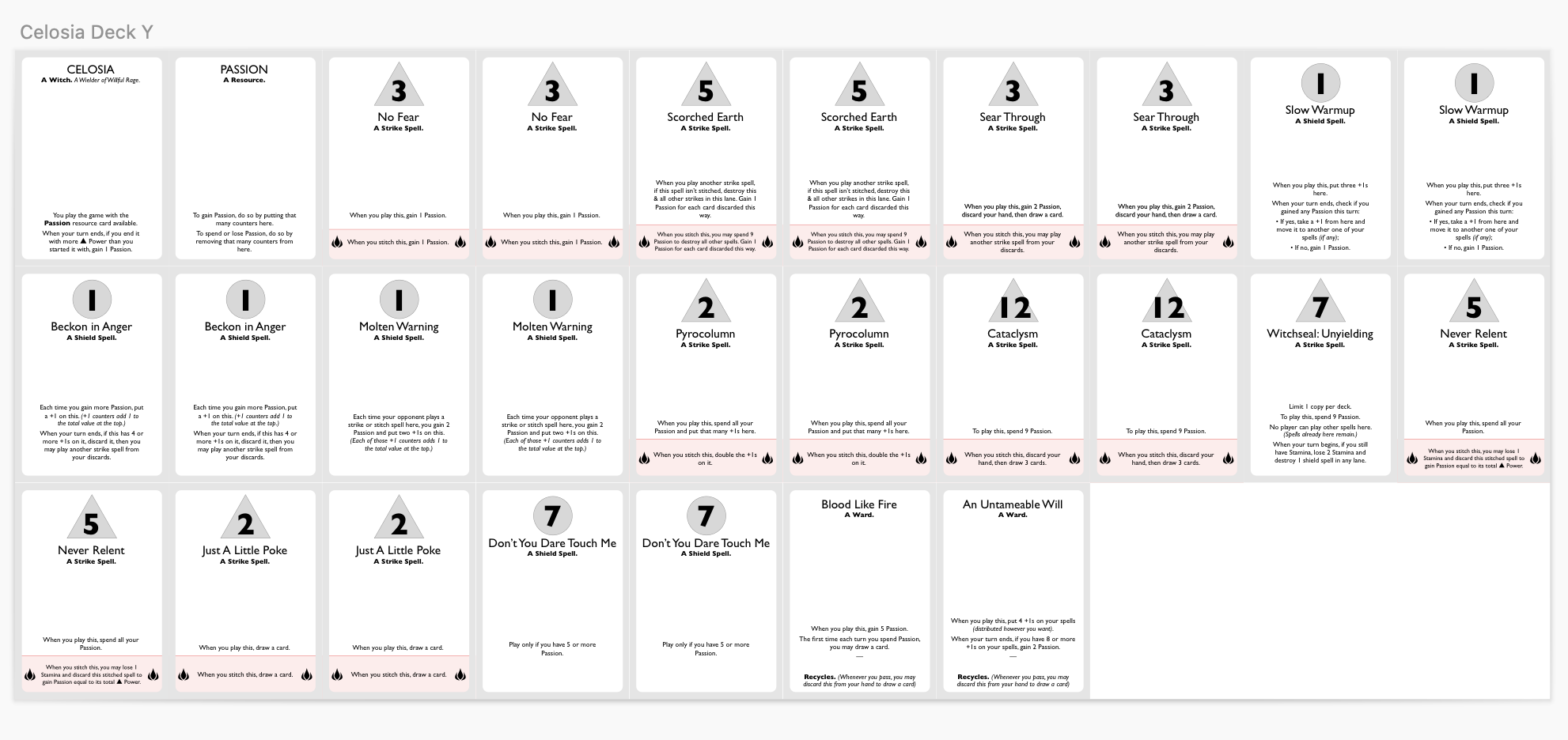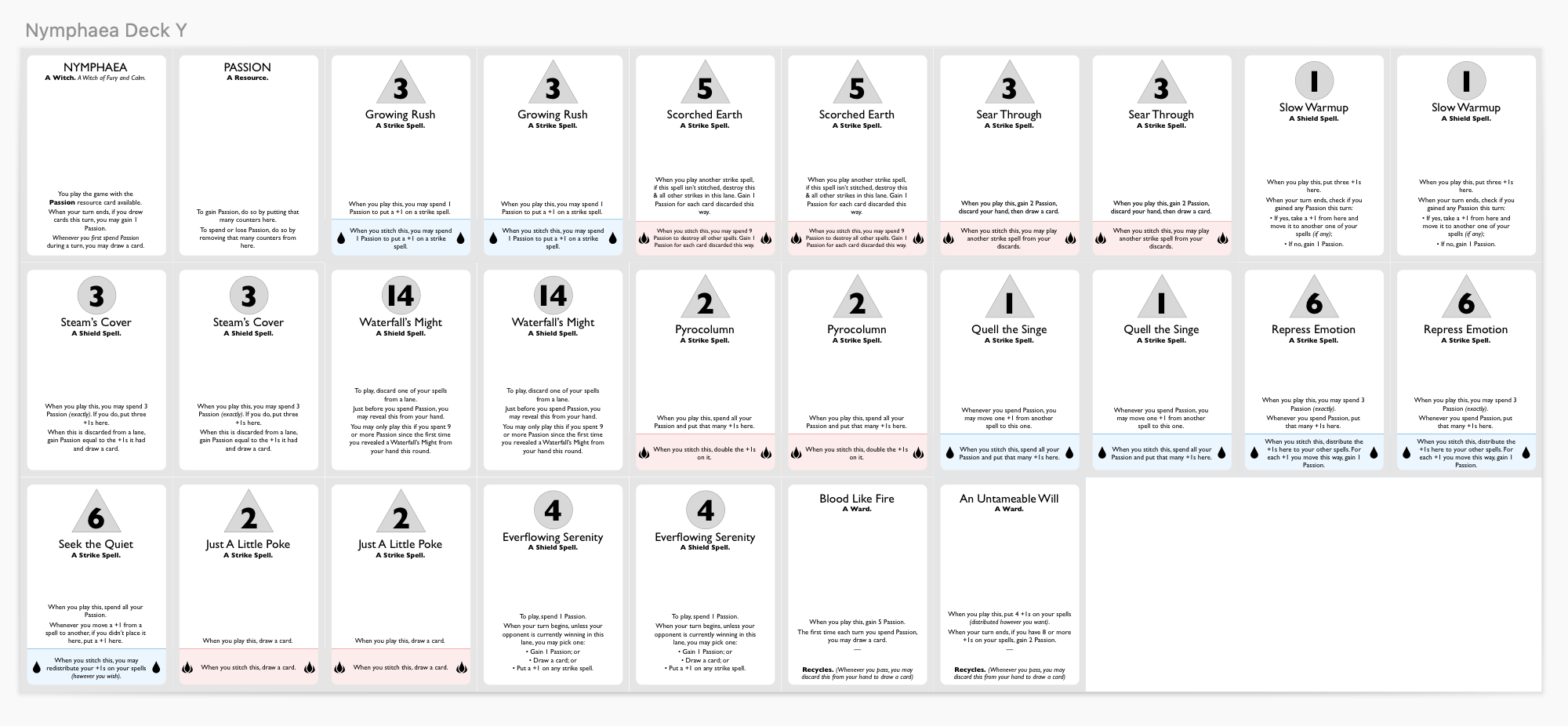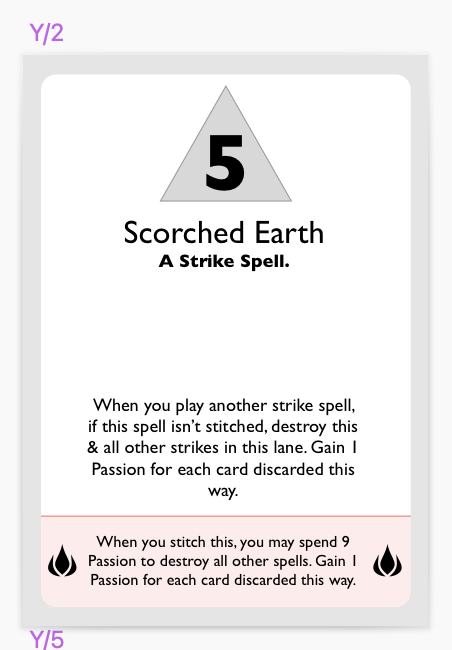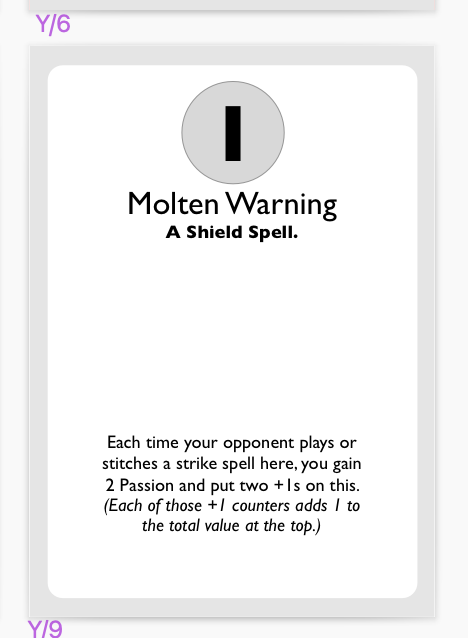A Partial Attempt for the HTCG Discord September '24 Jam: Witches' Revel In Potential Rhapsody: The Card Game.
Every six or so months, the Homemade TCG Discord Server hosts a game jam with interesting or weird constraints. I always try to participate, but I have some constraints that prevent me from feeling good about submitting my work — foremost of all, I often have high-concept ideas that really benefit from art, and I cannot hope to produce the volume of art required in the two weeks the jam lasts. On top of that, often my ideas move outside the exact realm of Trading (Collectible) Card Games; the HTCG Discord is geared toward a commercial ideal of card games that includes things like boosters, boxes and such other elements that exist as tropes for the genre at least partly because it is a commercial endeavor, and my focus and work is on reclaiming the genre in ways that are noncapitalist or anticapitalist, community-driven rather than commerce-driven, and where collection is not gated by monetary value but by interest and novelty. Often, these reflect in my designs as well, making them unsuitable for submission by design.
However, I try to at least have a novel mechanical take on the theme of the jam by the time it's over, and I think I wanted to document my work on Witches' Revel In Potential Rhapsody: The Card Game (or just Witches' Revel from now on) because I think some of these mechanical ideas are interesting per se and merit being preserved for further use, mine or others'.
Let me start with the process, and then detail the design I arrived at and what I feel is interesting about it.
Dolls to Witches
The theme of the jam is novel and different every time. This time, a community vote decided that each game would need to incorporate "stitch" as the theme: some part of the game, be it a verb, a noun, or a piece of flavor, would need to be built around that word and feature that word in the game.
When talking about stitching, my first thought, due to my mood at the time, turned to the idea of dolls in Empty Spaces (iykyk). The idea that the player would be a powerful witch, imbuing her doll with more and more effects by literally stitching them on, felt very interesting.
My first take was to build a game where the doll starts with some abilities, but has some of them in patches where you can stitch spells on. When you stitch over a patch, you lose that ability but gain the text on the stitch card:
You can see here that the doll has two patches with distinct icons. The underlying idea was to introduce icons and that you would need to match a patch's corner icon to the corner icon on the stitch you were playing. The doll would then determine what cards would be playable at all in the deck. You can see here also that one of the ideas I immediately turned to was the idea of introducing a subgame for actual in-game resourcing; by playing the sub-game correctly, you would then be able to exploit better effects down the line. Stitches would themselves have patches, on which more cards would then be stitched on (or not, as a costing mechanism).
This design had a number of issues:
- Three abilities per cards, and abilities that go away, immediately gave the game a much higher mnemonic/cognitive threshold than was comfortable. Having to play the minigame on top of knowing what's on, what's off, what needs to be turned on or off next, was really off-putting.
- The physical, on-table geometry of the game didn't quite work. Cards from both branches would eventually come to overlap outside of their patches, quite ruining the theme and worsening the complexity issue.
Given the above, I scrapped this design quickly. However, I was happy with some of the ideas in it. Using icon restrictions for deckbuilding was a good visual indicator. I was trying to incorporate themes from other designs in my drawer, namely the use of smaller deck sizes to reduce complexity, and the integration of a match structure into the game itself (rather than as a 'crutch' for competitive play), and those felt like they could play well. The resource minigame also felt like it had a lot of potential: there's interesting design space in cards that know or play around the idea you can gain a resource, coupled with choosing a game piece as your opener that twists the minigame dynamic in a way that is interesting or thematic.
Given the above, I then had the idea to turn to Marvel Snap as a source of inspiration. What if we kept the theme, but the player characters were now Touhou-style witches? The Marvel Snap multilane setup would come to represent the screen, slowly getting filled by showy bullet-hell attacks and blocks, and getting cleared once one of these danmaku patterns overwhelmes the opponent. I put myself to work integrating the good points of the previous design into this new skeleton.
The Design's Rulebook, In Detail
In Witches' Revel, the player embody two witches who are quarreling for reasons that don't quite really matter to the plot anyway. These witches will fill the field with powerful spells, trying to overwhelm one another.
To play, each player needs:
- A witch card, which represents the character they're playing. (Mirror matches are fine.)
- The witch card often will tell you to play her with a resource, a way to power her spells on the field.
- A deck of spells and wards, made out of 20 cards of your choice. You can have at most 2 copies of any one spell in the deck (except for wards and for spells that say explicitly so, where you are limited to 1 copy per deck).
The setup is as follows:
- Each player plays their witch card and any resource card the witch indicates on their side.
- Players set up a playing area between the witches. The middle is divided into four lanes, each of which has one spot for a spell on each side — theirs and their opponent's. Each player sets up a spot for a pile of lives cards and for one ward card, which start empty. And finally, each player marks 4 Stamina.
- Players randomly decide who goes first.
- Each player shuffles their deck, puts two cards (two lives) into their lives pile, and draws two cards.
- Then, the game begins with the first turn of the first round.
The object of the game is to win against your opponent in successive rounds of spellcasting might. Each time a round ends, the player who wins it gets to knock off one life out of their opponent's lives pile. If they win a round and the opponent has no lives left, that player loses the game.
Each turn works as follows:
- The player whose turn it is draws a card. (In the very first turn of the game, this doesn't happen, but happens in every subsequent turn, including the first turn of future rounds.)
- The player takes one action or passes:
- One action is to play a spell onto a lane that has a free space on your side.
- One action is to stitch two spells together, by playing one from their hand and joining it with one already in a lane to make a more powerful spell.
- One action is to play a ward into the empty ward position if there's one. This action can only be taken once per round.
- If a player passes, they get to draw a card, and discard a card. Passing in succession may end the round — see below!
Here's how to do each of those actions:
- Playing a spell: To play a spell, you pay any cost it has and then place it down in any one of your lanes with free space on your side. There are two kinds of spells:
- Strikes represent offensive magic. They have a ▲ Power value in a triangle. The player with most power in a lane will win on that lane at the end of the round!
- Shields represent defensive or preparatory magic. They have a ⚫️ Resistance value in a circle. Shields cannot win you a lane, but they will reduce the opposing ▲ Power in this lane by their resistance amount. If they have enough to put that opposing ▲ Power to zero, the opponent will not win on that lane (but neither will you). Many cards have effects that occur when you play them. Follow that text when you play a spell. One thing you can do when playing a spell is that you can discard a shield spell to replace it with a strike spell. No such thing is possible with strike spells: once a strike is in a lane, it will remain there until the end of the round or if discarded or moved by an effect.
- Stitching a spell: To stitch a spell, play it normally, but show that it has the same icon as another spell on one of your lanes. You can stitch a spell by playing it in the same lane as the other spell, even if it's already occupied, or in an empty lane adjacent to that spell, in which case the other spell card will move to join it. Once you stitch a spell, three things happen:
- The two spells get woven together into a single, more powerful stitched spell. Both cards will make up the one spell and occupy a single space on the lane together. Their ▲ Power will be the sum of the two cards' ▲ Power values, and any counters that were on them will end up pooled together onto the stitched spell.
- If the card is played on an adjacent lane, the other card you're stitching with will move away from its lane to join it in the new spot. This will free up the space in the lane it was originally in!
- The new card you just played was, in fact, played — this means that any 'When played' parts of it will work just as if you played it alone.
- All cards with stitching icon have a special effect that happens once they're stitched, which is separated by the main text and placed near the icons at the bottom of the card. When you stitch two spells together, both their stitch effects will happen. You get to pick the order in which relevant 'When played' and 'When stitched' effects happen, since they happen all at once.
- The two spells get woven together into a single, more powerful stitched spell. Both cards will make up the one spell and occupy a single space on the lane together. Their ▲ Power will be the sum of the two cards' ▲ Power values, and any counters that were on them will end up pooled together onto the stitched spell.
Note that a stitched spell cannot be further stitched again.
Also note that some effects may put "+1"s on top of spells. Put counters on those spells to represent that. Each +1 on a strike increases its ▲ Power by 1, and each +1 on a shield increases its ⚫️ Resistance by 1. If you stitch a spell, pool all the +1s on top of the final spell together.
- Playing a ward: To play a ward, if you don't already have one in the ward spot you prepared at setup, just put one down from your hand and follow its instructions. You can play a ward once per turn, and a ward you play gets lost for the rest of the game when the round ends, rather than be shuffled back with the rest of your cards for the new round.
- Some wards say they can recycle. You can recycle a card by discarding it from your hand and drawing a card prior to your action during a turn. This doesn't end the turn — you can still act, or pass to draw and discard again.
Once you take an action, the turn ends and your opponent takes a turn.
One last turn rule is that, as your turn starts, you need to check a condition called fatigue. Your witch is fatigued if either is happening:
- You have a stitched spell in any lane; or
- You have no free spots, even if you can still play cards (say, by discarding a shield to play a strike). If you're fatigued as the turn starts, you lose 1 Stamina just before you draw that turn. If you end a turn with no Stamina left, the round ends for you and you don't get any more turns. If your opponent has any Stamina left, they get a final turn for the round, which is similar to a normal turn, except:
- Your opponent can take any number of actions. (Passing ends the turn, and is not an action, though they do get to draw and discard.)
- Each action they take costs them 1 Stamina.
- Once they're out of Stamina, the turn ends rather than giving them another action. Ending this procedure ends the round.
Ending a round can also happen by passing. If a player passes, and their opponent is currently winning on at least two lanes, they can also pass to immediately end the round. If they aren't and pass, the game continues with the other player's turn. You're winning on a lane if you have more than zero ▲ Power in it (after reducing it by the opposing shield spell's ⚫️ Resistance, if any) and more ▲ Power than your opponent has there.
When the turn ends:
- Check who won. For each lane, check who's winning in that lane. A player that wins more lanes than their opponent wins the round. A player that wins all four wins overwhelmingly. If there's a tie, count total ▲ Power on each side, with the player with most ▲ Power winning the round; and if the tie remains, discard all shields and try again. (A tie after this check ends the round with no winner.)
- The player who lost draws a random life from their pile. If the pile was empty, they lose the game. If they lost overwhelmingly, they draw two lives (and lose if they can't)!
- Each player loses their played ward for the rest of the game and discards all cards from all lanes. (Set the ward aside out of play.)
- Players shuffle their discards back into their deck, and a new round begins, with the player who lost going first. (If it was a tie, the player who played the last turn of the round also goes first in the new round.)
The Intangibles
Let's look at the preconstructed deck I designed to see how resources, which aren't addressed at all in the rules otherwise, affect the game.
This is a deck with Celosia, a witch designed to play well with strikes that bear the 🔥 symbol. She encourages an aggressive play style: if you want to trigger her value, you need to be playing strike spells, which fill your lanes and perhaps make the round end for you faster than you'd like it to. She enables Passion, which is a simple counting resource — you gain some Passion, and then spend it later for effects; Celosia is a source of Passion that enables bigger Passion plays if you're aggressive, especially after reaching a threshold of 9 Passion. Finally 🔥-symbol cards support this play style, and in fact help with the aggression problem with designs like Scorched Earth or Never Relent, which discard themselves, freeing up the lane for further use, or encourage you to stitch them for explosive effect, freeing the adjacent lane — or, for Never Relent, both!
You can see here how it can be interesting to decouple this design on three axes. Passion is a powerful theme but has no specific bearing on the game itself, meaning that Passion-based designs can shift over time as needed. 🔥-symbol cards as presented here reward a specific play style for Passion decks, one that rewards gaining a lot of Passion and then using it all for one big or impactful play. Finally, Celosia herself resonates with both theme and mechanics for 🔥 cards, but does not necessarily mandate the latter. This allows this deck to be pulled apart and rebuilt for other uses, and for disparate parts to contribute to a different play style with the same elements.
Contrast, for example, the second precon, featuring Nymphaea:
Nymphaea is still a Passion witch, but one built around the idea of using 💧-symbol cards. Those cards are still Passion-themed, but reward you for spending smaller amounts of Passion and make it harder to gain Passion — but then reward you with more flexibility as they turn that resource into +1s that can flexibly flow around. Nymphaea herself enables this play style by giving a small reward on spending Passion and providing a Passion trickle to round out the smaller gain as a reward for following the +1s game plan. Note how we can spend some opportunity cost here by making the deck two-symbol: pieces from the 🔥 collection can be used to provide better Passion gain, and since drawing cards is a small but good secondary theme built into that symbol, Nymphaea can tie her trickle economy to that as well to encourage this kind of build (but not require it!).
This allows a resource minigame to be resonant while still fitting multiple unrelated play styles, and allows higher flexibility in a game with a very small deck size. Due to that, and the fact that the second box on all cards is ignored until stitching (and a general move to many more 'When played' effects on strikes, rather than ongoing ones), complexity is generally within a margin I am comfortable with while still producing interesting active-reactive board states.
Other resource minigames I designed that could make the cut but I hadn't time to elaborate on were:
- Eldritch offerings: A theme resource for eerie or self-damaging witches. When a player makes an eldritch offering — a game term that the resource does not define itself — it is marked on the resource card with a counter; at the fourth eldritch offering, counters are removed, the card flips to a Eldritch Surge side, and then stays there, ignoring any further offerings, until the end of that player's next turn. The idea here is to let a witch or early-game spells define what needs to be done to make an eldritch offering, and then have powerful explosive payoffs for things played during an eldritch surge — or even better, if the round ends shortly after the surge payoffs were played.
For example, a sacrifice-themed witch would perhaps have: "When your turn begins, you may discard one of your spells to make an eldritch offering." A strike payoff could be: "When you play this during your Eldritch Surge, put five +1s on this", and "Each time your opponent plays or stitches a spell, remove a +1 from this", to force you to capitalize on a surge perhaps later than you would like.
- Grace: A theme resources for witches that are based upon elegance and constriction, and the loss thereof. When a player gains grace, which they can only do once per turn, they mark it on the resource card with a counter. If a player ever has a turn that ends without having gained grace, they lose all grace — all the counters on the card. The idea is to foreshadow some options and require the player to call some shots to continue receiving grace, but also to have powerful payoffs that would require them to lose grace to occur; the intent here is to tie this to successive actions, and always letting passing without action cause a loss of grace.
For example, an elegant witch may have a starter grace-gainer: "When you play a strike after having played a shield last turn, or play a shield after having played a strike last turn, if you don't have grace, gain it." A stitchable spell may have: "When you stitch this, gain grace." A strike may have "When you play a ward or a shield spell next turn, gain grace." And, finally, a hypothetical Look What You Made Me Do spell may have "When you lose grace, you may discard this and play another spell from your hand. Put as many +1s on it as you had grace counters when you lost them."
Some Lessons Learned
Rather than a full accounting of the design's evolution, I am going to highlight some lessons learned while working on the bones of the second design.
First: the game ends very quickly once fatigue is achieved. Being able to escape fatigue, or even just handle the flow of the game without exhausting the available lane spaces felt in basic playtesting like a basic competency in the game, and a verb that needs to be available as needed.
In the very first pass of the designs, stitches were their own cards, much like the original. Stitching was the only way to free up a lane in this design; given that there could be very few stitches in a 20-card deck that also needed space for the other card types, it meant that that basic verb was basically not available for most of the game.
This was largely solved by making shields 'temporary', in that they can fill a lane but can always be discarded in favor of a strike, and more importantly by making stitching an action for any two compatible spells rather than key it to a specific card type. This also reduced the complexity of stitching somewhat, by not making stitch cards add to the bevy of effects that would already occur on stitching.
One important lesson in this vein is about Scorched Earth:
This card feels pivotal to the Passion archetype. It can be used to bluff, and close up a lane that the opponent will then have to figure out a trade in. It can be stitched to prevent its mandatory destruction effect to go off, even if you don't have enough Passion to trigger the board wipe. It can, in fact, wipe the board and set you up for a big comeback if you so desire. And, finally, it is a big source of Passion itself that you can trigger by not necessarily giving up on tempo, which can be played reactively to then trigger and clear the lane. And, of course, it is still a 5-power strike that can still dominate a lane if the player foresees the round ending soon. All in all, this was one of the most successful 🔥 designs entirely.
One of the less succesful is Molten Warning:
Molten Warning was designed as a deterrent that the opponent could still play around. Any 4-power or better strike wins the lane while giving back resources to the shield's player and setting them up for a better play; it also makes stitching less viable in its lane. In its original design, the effect was even greater, which caused the lane to be 'lost' — there was little advantage to play into it, since the Passion swing could help the opponent greatly, and this let a lane essentially languish until the endgame, should the player of this card need to replace this with a real strike. The final version of this card toned down the Passion and +1 gain to 2 and 2, down from the initial excessive push of 4 and 4, given the awkward 6-strength breakpoint, and now only matches the power level of the original if the opponent decides to stitch in the lane, playing twice in it. Even 2 Passion can be a powerful bump toward the 🔥 magical big-play amount of 9 Passion, and so encouraging the opponent to play here preserves a lot of the original intent.
Witches' Revel in Review
I'm pleased by the mechanical aspects of building on the bones of Marvel Snap in this way. The games I've playtested in hotseat solo were very enjoyable and not predictable, despite the lower variance of the card pool. Certain aspects — namely 💧 cards and wards — haven't gotten as much testing as I was hoping for, but the combination of simple built-upon mechanics, resource minigames, and the natural action ceiling of playing to a dwindling (but manageable) number of spaces made for exciting, game-end races to fulfill resource objectives while tightly managing plays and tempo. In short, a bit of a success! It may not release at all, but I hope the mechanical inspiration can live on and reap the better parts of the design into other frameworks (or, who knows? I may also pick this up again in the future).

